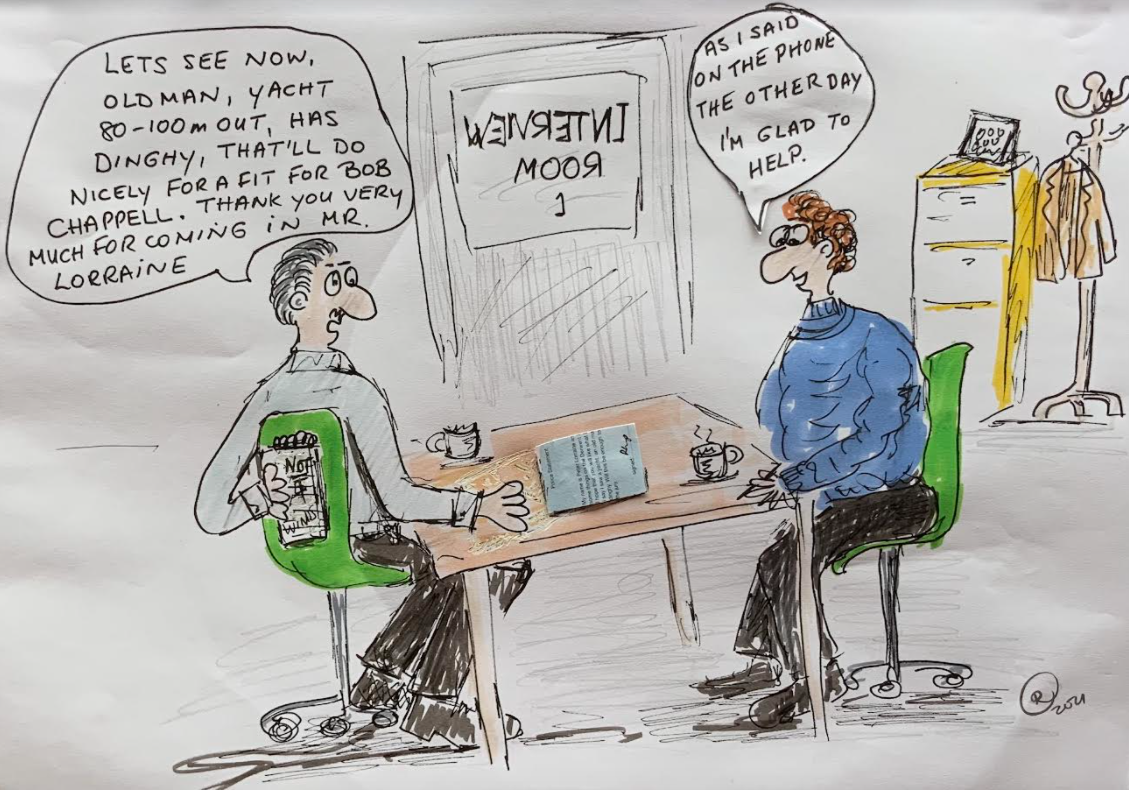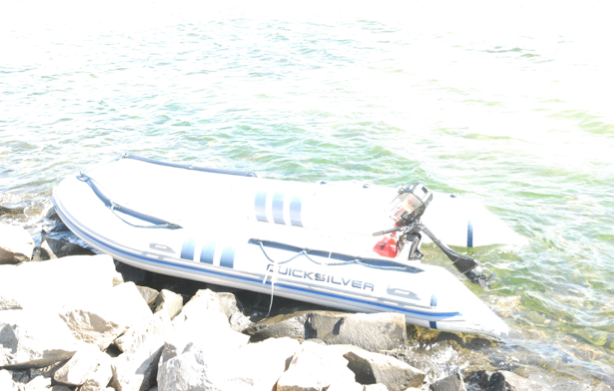The following excerpt from the Etter/Selby papers reveals how the jury, the defence and the judge were all misled at the murder trial of Sue Neill-Fraser in 2010 by the eye witness testimony describing a dinghy alongside Four Winds (crime scene), which was incorrectly presented to the jury and omitted critical details; a handwritten police note. (Paragraph numbers refer to the papers dated August 11, 2021.)
3. Peter Lorraine was presented at trial by the prosecution as an independent witness who on Australia Day 2009 saw an old man (CT 1409) and possibly the Four Winds yacht and its dinghy around 5pm. That timing made it possible for the accused Sue Neill-Fraser (SNF) to be on the Four Winds at a time when she claimed she was ashore. It also meant that the victim Bob Chappell was seemingly alive at 5 pm so had not come to grief via the occupants of the grey or different dinghy seen by various other people alongside the Four Winds that same day and around the same time (Conde, Clarke and P36) or in a relevant area in the lead up to Australia Day (Smith – in the leave to appeal hearing on 31 October 2017).
4. Because he was independent, and because the Defence had no inkling as to the extent of the misleading nature of his evidence (particularly given disclosed and incomplete information on the Police Investigation Log), they accepted him and his evidence as credible. Moreover, they accepted him as more credible than their client who has always said that she had left the Four Winds earlier and left the dinghy much earlier, probably around 3 pm (having spent about an hour on the boat – CT 1157). Here is what Defence counsel said in his closing to the jury (CT 1442 – see also CT 882 in absence of jury):
“We know that on one view, Mr Lorraine, that Mr Chappell was sighted at about five o’clock by him with the grey dinghy behind and whilst Sergeant Conroy didn’t seem to be terribly convinced at the beginning that Mr Lorraine had seen Mr Chappell he seemed to come around to the proposition that that was right, given where the boat was situated, and I would suggest to you that it almost certainly was Mr Bob Chappell at five o’clock. Nobody reported seeing him being on the deck after that. That of course depends on a finding that you make as to whether you accept Mr Lorraine that it was Mr Chappell, I submit to you you could.”

5. In January 2020, Barbara Etter unexpectedly came across new material – official pieces of paper from credible sources (Tasmania Police and the Integrity Commission) which prove that the jury, the trial judge, and the defence were misled. The evidence disclosed to the defence and elicited from Mr Lorraine by the Crown Prosecutor was wholly inconsistent with the earlier, more contemporaneous account that Mr Lorraine gave over the phone to police officer Sinnitt on 27 January 2009. Officer Sinnitt made notes. They do NOT describe the Four Winds’ dinghy.
6. That first account was written down by Sinnitt, but neither it nor a later handwritten police running sheet (or other related documents such as the police timeline) were disclosed to the defence prior to the 2010 trial.

The Four Winds dinghy (police photo)
7. Peter Lorraine’s seeming credibility (although his evidence did vary somewhat) entailed that SNF’s claim to have been ashore was less credible, while the evidence from other witnesses of sighting another dinghy (being a grey one) alongside the Four Winds yacht was also less significant. [In light of Ms Vass’ 2019 admission to having been aboard with two males, this grey and different dinghy becomes important. See in particular the evidence from Conde (diagrams and a first and second statement taken during the trial)].
8. The Crown Prosecutor argued at trial that the sightings of the grey dinghy by Conde and Clarke were in fact sightings of the Four Winds’ dinghy (CT 60 in the DPP’s opening – “I mean obviously given that there was a dinghy alongside it she must have still been on board and that she’d stayed there longer than she thought”), and that the suggested grey and different dinghy was a “red herring”. See, for example, CT 858 (in absence of the jury) and his closing address from CT 1408-1411.
9. The evidence of Lorraine – especially as it was largely dependent upon the accuracy of his description of the dinghy – was incriminatory, not exculpatory, as can be seen by the Judge’s sentencing comments in October 2010. Justice Blow (as he then was) had this to say about Lorraine’s evidence:
“A witness named Peter Lorraine gave evidence of observing a man on a yacht moored off Marieville Esplanade at about 5 pm on 26 January. From his description of the yacht and the man, I am satisfied that at that time he observed Mr Chappell on the deck of the Four Winds. He gave evidence that he saw a dinghy tied up to the yacht at that time.
Ms Neill-Fraser told the police, and confirmed in her evidence at the trial, that she left the Four Winds alone in its tender that afternoon, leaving Mr Chappell on board, and that she travelled to the wharf of the Royal Yacht Club of Tasmania, where she tied the tender to the wharf near a ladder. I am not able to make a finding as to when she did that.”
and
“On the basis of the evidence that I have referred to, I make the following findings:
Mr Chappell was alive at about 5 pm on 26 January, when Mr Lorraine saw him, but was not seen alive by anyone other than Ms Neill-Fraser after that time.
Ms Neill-Fraser attacked Mr Chappell either between 5 pm and about 9 pm, or at about midnight …”
10. Justice Blow had also made the point in summing up at CT 1525 that if Mr Lorraine saw Mr Chappell at about 5 pm his evidence would tend to suggest that Mr Chappell showed no sign of apprehending any danger at that time. His Honour stated:
“So what are the possibilities? Did all of these witnesses see the Four Winds’ dinghy and inaccurately describe it, or did all of them see the Four Winds’ dinghy and where their descriptions don’t tally they just made mistakes? Was there a dinghy not from the Four Winds that tied up to the Four Winds and if so was the visitor that came aboard innocent or someone responsible for the disappearance of Mr Chappell? Was there more than one such visitor? Well these are all matters for you. If Mr Lorraine saw Mr Chappell at about five o’clock his evidence would tend to suggest that Mr Chappell showed no sign of apprehending any danger.”
(The Etter/Selby papers have been tabled in Parliament and enjoy Parliamentary privilege.)
PODCAST – The Man Who Wasn’t There, by Hugh Selby
SPOTIFY: https://open.spotify.com/show/4i3hLaD13xS7F1Z8vXlYS4
GOOGLE PODCASTS: https://podcasts.google.com/search/THE%20MAN%20WHO%20WASN’T%20THERE
APPLE PODCASTS:
https://podcasts.apple.com/us/podcast/the-man-who-wasnt-there/id1585924495

If even one innocent person is incarcerated none of us are truly free.
Everybody keep up the pressure.
Rodger Warren
What a hodge podge is the trial of 2010. Even in his summing up to the Jury Justice Blow has no idea what is going on. The trial should have been aborted from Day 1 when Mrs Zochling corrected her id that she saw Bob’s sister not Sue and it was ignored. The start of a long line of errors and misleading evidence. It should be an embarassment to all the judiciary that it went ahead at all. Its never too late to admit the errors and let Sue be free.
Justice for Sue!